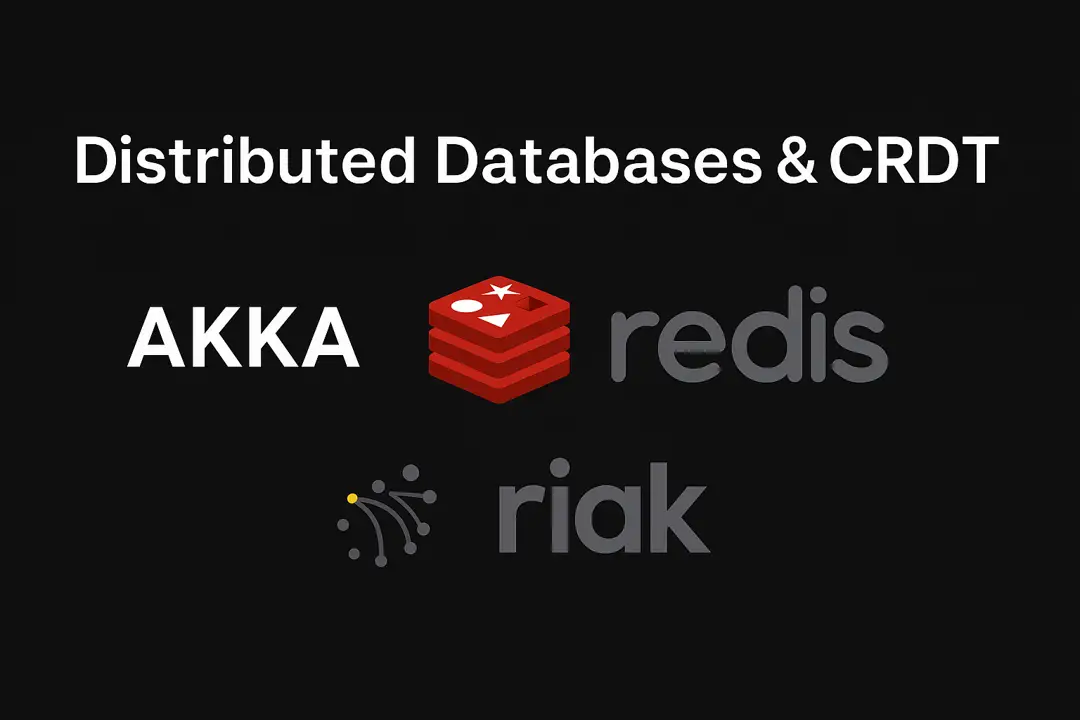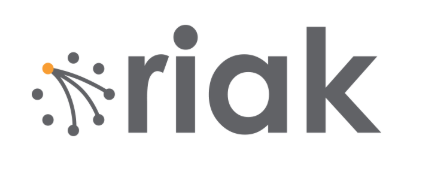Distributed Databases & CRDTs: Redis, Riak, Akka
Introduction
Distributed databases are the backbone of modern, scalable applications. They enable data to be stored and processed across multiple nodes, ensuring high availability and fault tolerance. But how do these systems handle data consistency and conflict resolution? Enter CRDTs (Conflict-free Replicated Data Types), a family of data structures designed for distributed, eventually consistent systems.

Distributed DBs: Consistency, Availability, Partition Tolerance
What are CRDTs?
CRDTs are data structures that can be replicated across multiple computers in a network, where the replicas can be updated independently and concurrently, without coordination. When the replicas synchronize, they are guaranteed to converge to the same state. This makes CRDTs ideal for distributed databases and collaborative applications.
CRDTs: Independent updates, eventual convergence
Popular Distributed DBs using CRDTs
Redis (CRDT Module)
Redis, a popular in-memory data store, offers a CRDT module for geo-distributed deployments. It enables multi-region Redis clusters to resolve conflicts automatically using CRDTs, supporting counters, sets, and more.

CRDT Types & Real-World Examples
| CRDT Type | Example Use |
|---|---|
| G-Counter | Counting likes/views |
| OR-Set | Managing sets with add/remove |
| LWW-Register | "Last write wins" fields |
| RGA | Text editing (collaborative) |
CRDT Types: G-Counter, OR-Set, LWW-Register, RGA
How CRDTs Work
- G-Counter: A grow-only counter. Each node increments its own counter; merging is done by taking the maximum for each node and summing.
- OR-Set: Observed-Remove Set. Supports add/remove operations. Handles concurrent adds/removes without conflicts.
- LWW-Register: Last-Write-Wins. Stores a value and a timestamp; the latest timestamp wins on merge.
- RGA: Replicated Growable Array. Used for collaborative text editing, allowing concurrent insertions/deletions.
Why Use CRDTs?
- Enable eventual consistency without manual conflict resolution
- Support offline-first and collaborative applications
- Reduce coordination overhead in distributed systems
- Power geo-distributed databases and real-time apps
Case Study: Real-Time Collaborative Document Editing
Scenario
Imagine a global SaaS company offering a collaborative document editor (like Google Docs) to users worldwide. The application must support real-time editing, offline access, and seamless collaboration, even when users are on different continents or temporarily offline.
Users in different regions connect to the nearest DB node
Key Distributed DB Features in Action
- Geo-Replication: Each user connects to the nearest data center. Edits are replicated across regions for low latency and high availability.
- Conflict Resolution with CRDTs: When users edit the same document concurrently (even offline), CRDTs like RGA (Replicated Growable Array) ensure all changes are merged without conflicts.
- Eventual Consistency: Updates propagate asynchronously. All users eventually see the same document state, even if edits arrive out of order.
- High Availability: If a data center goes down, users are redirected to another region with minimal disruption.
- Offline Support: Users can edit documents offline. When they reconnect, their changes are merged automatically using CRDT logic.
How It Works (Step-by-Step)
- User A in India and User B in the USA both open the same document and start editing.
- Each user's changes are written to their local/nearest DB node, using a CRDT (e.g., RGA for text).
- If User B goes offline, they continue editing. Their changes are stored locally.
- When User B reconnects, their edits are merged with the global state using CRDT merge rules—no manual conflict resolution needed.
- All users see a consistent, up-to-date document, regardless of edit order or network delays.
Benefits
- Seamless real-time collaboration across the globe
- No data loss or manual conflict resolution
- Resilient to network partitions and outages
- Scalable to millions of users and documents
Distributed Database Internals: Architecture Deep Dive (2025)
- Partitioning (Sharding): Data is split across nodes for scalability. Modern systems use hash, range, or directory-based sharding.
- Leader Election & Consensus: Protocols like Raft and Paxos ensure a single leader for writes, supporting strong consistency when needed.
- Anti-Entropy & Vector Clocks: Used for background synchronization and conflict detection, especially in AP systems like Riak.
- Replication Strategies: Synchronous (CP) vs. asynchronous (AP) replication, geo-replication for global low-latency access.
CRDTs in Production: Redis, Riak, Akka
- Redis CRDT Module: Implements state-based and operation-based CRDTs for geo-distributed clusters. Uses vector clocks for versioning and automatic conflict resolution.
- Riak: Native support for counters, sets, maps, and registers. Uses vector clocks and sibling resolution for eventual consistency.
- Akka Distributed Data: Provides a rich set of CRDTs (GCounter, ORSet, LWWRegister, RGA) for actor-based state sharing across JVM clusters.
Trade-offs & Limitations of CRDTs
- Metadata Overhead: CRDTs require extra metadata (e.g., vector clocks), increasing storage and network usage.
- Merge Complexity: Some CRDTs (like RGA) have complex merge logic, which can impact performance at scale.
- Not Universal: Not all data types or business rules can be modeled as CRDTs. Strong consistency may be required for financial or transactional data.
- Eventual Consistency: May not be suitable for use cases needing strict ordering or immediate consistency.
CAP Theorem, Consistency Models & CRDTs
The CAP theorem states that a distributed system can only guarantee two of the following three: Consistency, Availability, Partition Tolerance. CRDTs are a key enabler for AP (Availability & Partition Tolerance) systems, allowing for eventual consistency without manual conflict resolution. For CP (Consistency & Partition Tolerance) systems, consensus protocols and synchronous replication are used, but at the cost of availability during partitions.
Architect's Decision Point: Choosing a Distributed DB or CRDT Type
- Latency Requirements: Choose AP/CRDTs for low-latency, global apps; CP for strict consistency.
- Data Model: G-Counter for metrics, OR-Set for tags/membership, LWW-Register for config, RGA for collaborative text.
- Operational Complexity: Consider ease of deployment, monitoring, and scaling.
- Cloud-Native Support: Prefer DBs with managed services, Kubernetes operators, and observability integrations.
- Regulatory/Compliance: Use CP/strong consistency for regulated data (finance, healthcare).
Evaluate your use case against these criteria to select the right distributed database architecture for 2025 and beyond.
Migration & Integration: Cloud-Native Distributed DBs
- Legacy Migration: Plan for data model transformation, downtime minimization, and dual-write/dual-read strategies during cutover.
- Kubernetes & DBaaS: Use managed distributed DBs (e.g., Redis Enterprise, Riak Cloud, Akka on Kubernetes) for scalability and operational simplicity.
- Integration: Leverage cloud-native tools (service mesh, distributed tracing, Prometheus/Grafana) for monitoring and resilience.
Performance, Monitoring & Observability
- Metrics: Monitor replication lag, merge frequency, and node health using Prometheus, Grafana, or cloud-native dashboards.
- Distributed Tracing: Use tools like Jaeger or OpenTelemetry to trace requests across nodes and regions.
- Alerting: Set up alerts for partition events, replication failures, and abnormal merge rates.
- Capacity Planning: Use historical metrics to plan for scaling and failover scenarios.
2025 Trends & Future Outlook: Distributed DBs & CRDTs
- Multi-Cloud & Hybrid Deployments: Distributed DBs are increasingly deployed across multiple clouds and on-premises for resilience and compliance.
- Edge Computing & IoT: CRDTs enable data sync and conflict-free collaboration at the edge, powering next-gen IoT and mobile apps.
- AI/ML for Distributed Data: Machine learning is being used for anomaly detection, predictive scaling, and even automated conflict resolution in distributed systems.
- Serverless & Event-Driven Architectures: Integration with serverless platforms and event-driven patterns is on the rise for real-time, scalable data processing.
Q&A: Distributed DBs & CRDTs
Q: What is a distributed database?
A: A distributed database is a database in which data is stored across multiple physical locations (nodes or data centers), providing high availability, fault tolerance, and scalability. Nodes communicate and synchronize to ensure data consistency.
Q: Why are CRDTs important in distributed systems?
A: CRDTs (Conflict-free Replicated Data Types) allow data to be updated independently on different nodes and later merged automatically, guaranteeing eventual consistency without manual conflict resolution. This is crucial for collaborative and geo-distributed applications.
Q: How do distributed databases handle network partitions?
A: Distributed databases use strategies like eventual consistency, replication, and CRDTs to ensure that data remains available and can be reconciled after partitions heal. Some systems prioritize availability, while others may prioritize consistency (see CAP theorem).
Q: Can CRDTs be used for all types of data?
A: CRDTs are ideal for data types where automatic merging is possible (counters, sets, registers, collaborative text). For complex business logic or strict consistency requirements, other approaches may be needed.
Q: What are some real-world applications of CRDTs?
A: Real-time collaborative editors (like Google Docs), distributed caches, messaging apps, and offline-first mobile apps all use CRDTs to enable seamless, conflict-free collaboration and data sync.
Best Practices & Pitfalls
Best Practices
- Choose the right CRDT type for your use case
- Test for convergence and edge cases
- Monitor replication lag and system health
- Document your data model and merge logic
Common Pitfalls
- Misunderstanding eventual consistency
- Improper CRDT selection
- Ignoring network partitions
- Lack of monitoring and alerting
Next Steps
Now that you understand distributed DBs and CRDTs, you can explore:

